BY SAYAKA MATSUOKA | PG. 8

DEC. 15 - 21, 2022 TRIAD-CITY-BEAT.COM Another book ban fails pg. 4 Curing violence in W-S pg. 5 Art pops up in W-S pg. 10
New book examines how historical, marginalized Christian communities influence modern social-justice movements
e’ve made a hire for our new City Beat position — big news around here, as it doubles the size of our full-time news staff and exponentially increases our coverage of city government.
You’ll meet them soon.
In the meantime, we need to get them up to speed on both the Greensboro and Winston-Salem city councils, their differences and similarities, and the labyrinthine processes of city business.

Some of that falls to me.
I’m not the longest-serving journalist currently working in the Triad, but I’m up there — I’ve been writing and editing council stories for almost 20 years. I go back five mayors in Greensboro; in Winston-Salem, just one. I’ve watched district and at-large reps get elected, re-elected and un-elected. I remember when a young Derwin Montgomery worked the Early Voting System to take out longtime incumbent East Ward Joycelyn Johnson in 2013. I saw Bill Knight upset Yvonne Johnson in 2009 — the only two years since 1993 she had not served on council. And I watched current Greensboro Mayor Nancy Vaughan move from her at-large seat to take out political heavyweights Robbie Perkins in 2013 and Justin Outling this year.
I sat through the Greensboro Police scandal of the late aughts, the birth of the Innovation Quarter, the down-
town parking wars, the White Street Landfill debacle, the confederate monument, the rise and fall of Trudy Wade, a Greensboro redistricting plan submitted to Greensboro City Council by Mary Rakestraw that she claimed to have found on her doorstep the night before.
And so much more.
Though my own is somewhat affected by years of abuse, institutional memory is perhaps the most important asset a news organization possesses. It’s the old farts in the newsroom who remember Zack Matheny’s first council race (2007) or Allen Joines’ job before he became mayor of Winston-Salem in 2001 (deputy city manager, which never happens).



The young reporters need this context, and I’m at the point where they all look like young reporters.
This is the first thing that came to mind when I learned that the News & Record had laid off Managing Editor Jennifer Fernandez last week. She had been there since 2012, the most senior voice on the news staff, and out the door with her went the accumulated knowledge of her and everyone who came before that graced her with their wisdom.
Nowhere are events of very recent history more important than in a newsroom. It’s here where we reveal the narrative of a city, help discern its character by recording its successes and failures, keep the fires of public record burning for now and future generations.
Anyone who cannot understand that does not belong in the news business.
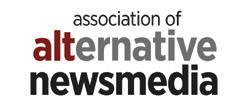
2 UP FRONT | DEC. 1521 , 2022
1451 S. Elm-Eugene St. Box 24, Greensboro, NC 27406 Office: 336.681.0704 First copy is free, all additional copies are $1. ©2022 Beat Media Inc. TCB IN A FLASH @ triad-city-beat.com BUSINESS PUBLISHER/EXECUTIVE EDITOR Brian Clarey brian@triad-city-beat.com PUBLISHER EMERITUS Allen Broach allen@triad-city-beat.com OF COUNSEL Jonathan Jones EDITORIAL MANAGING EDITOR Sayaka Matsuoka sayaka@triad-city-beat.com CHIEF CONTRIBUTORS James Douglas james@triad-city-beat.com ART ART DIRECTOR Charlie Marion charlie@triad-city-beat.com SALES KEY ACCOUNTS Chris Rudd chris@triad-city-beat.com AD MANAGER Noah Kirby noah@triad-city-beat.com CONTRIBUTORS Carolyn de Berry, John Cole, Owens Daniels, Luis H. Garay, Kaitlynn Havens, Jordan Howse, Matt Jones, Autumn Karen, Michaela Ratliff, Jen COVER: Book cover by Baker Publishing Group Book design by Gayle Raymer Cover image by istockphoto EDITOR’S NOTEBOOK WEBMASTER Sam LeBlanc Sorensen, Todd Turner by
If you read then you know... . How Greensboro bought pop-up shelter for the homeless . where the panaderías are . about guilford county’s book challenges TRIAD CITY BEAT — If you know, you know To get in front of the best readers in the Triad, contact Chris. chris@triad-city-beat.com
I’m not the longest-serving journalist currently working in the Triad, but I’m up there. Institutional memory and the news
Brian Clarey
W
by MICHAELA RATLIFF
THURSDAY Dec. 15
Warm for the Holidays @ Gas Hill Drinking Room (W-S) 8 p.m.
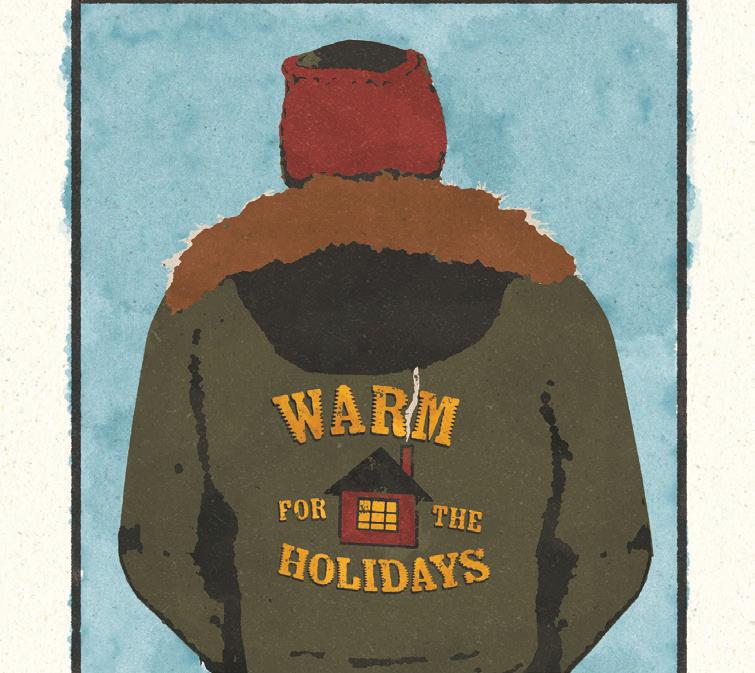
FRIDAY Dec. 16
Jazz Night @ the Brewer’s Kettle
(HP) 6 p.m.
DEC. 15-20
SUNDAY Dec. 18
Drafts on the Pass @ Paddled South Brewing Co. (HP) 6 p.m.

The Ramkat is hosting a winter coat drive and benefit concert for The Shalom Project, a local non-profit that aims to provide basic necessities like medical care, clothing and food to those in need. Performances will be by Jeffrey Dean Foster and The Arrows with special guest Crenshaw Pentecostal. Purchase tickets at theramkat.com
Get ready for the holidays with the Geoff Clapp Trio at the Brewer’s Kettle. Bask in the gift of jazz while enjoying a selection of beer, wine and cigars. Visit the event page on Facebook for more information.

SATURDAY Dec. 17
In Tune Winter Concert @ International Civil Rights Center and Museum (GSO) 7 p.m.
In Tune is hosting a winter concert with spoken word and poetry performances, networking opportunities and more to enjoy. Arrive at 5:30 for a tour of the museum. Learn more about In Tune and purchase tickets at intunegso.com
Paddled has partnered with Merric Jackson of Down River Catering to bring you an exclusive fivecourse meal, with each course being paired with a Paddled brew. Purchase tickets at the brewery.
TUESDAY Dec. 20
Christmas at the Movies @ Clemmons First Baptist Church (Clemmons) 7:30 p.m.
Enjoy musical selections from Home Alone, Polar Express and more during this free holiday concert by Salem Band. For more information, contact Dr. Eileen Young, Music Director of Salem Band at musicdirector@salemband.org.
3 UP FRONT | DEC. 1521 , 2022
by Sayaka Matsuoka
More than a week after the Guilford County Board of Education heard a challenge to the book Salvage the Bones, the board gathered once again on Dec. 8, this time to hear a challenge to a different book.
On Thursday afternoon, parent Jim Morris brought his challenge of Life is Funny by ER Frank to the school board after Northern Guilford High School’s media and technology advisory committee voted to retain the book in the school’s library earlier this year.
Like the hearing that took place on Nov. 29, appealing the advisory committee’s decision to the school board is the last level for a challenge of this type.
As in the vote that took place for the Salvage the Bones challenge, a majority of the school board members present voted to retain Life is Funny in schools. All of the board members, except for Linda Welborn of District 4, voted to retain the book. Board members Khem Irby (District 6) and Anita Sharpe (District 2) were absent from the meeting. District 3’s seat was also vacant because Pat Tillman, who up until recently held that seat, is now on the Guilford County Board of Commissioners.
Morris, who attended the special board meeting during his lunch break, said that he took issue with Life is Funny because of a graphic sex scene that takes place in one part of the book. The novel, unlike Salvage the Bones, which was assigned in an AP English curriculum earlier this year, is just part of Northern Guilford High School’s library.
During his comments, Morris said that not every student that has access to the
high school’s library is 18 years old, with most of the students being minors. That being said, he felt that the graphic sex scene was inappropriate for a majority of the students at the school.
Life is Funny was published in 2002 and follows the lives of 11 diverse teenagers who live in Brooklyn.

As stated during the Nov. 29 meeting, the reason for removing a book from a school’s curriculum or library must be constitutional. For that to be the case, the book must be educationally unsuitable, pervasively vulgar or be inappropriate for the age, maturity or grade level of the students.
In the end, many of the school board members argued that despite the book’s inclusion of the sex scene, the book had educational merit because of its diverse storytelling.
Vice-chair Winston McGregor also noted that the book had only been checked out three times since it was introduced into Northern’s library — once in 2013, 2016 and in 2022. Since the book was checked out this year, it has not been returned. Morris joked that he bought his own copy and that he wasn’t the one that was keeping the library’s copy.
Morris also admitted that his goal wasn’t to ban the book from the school outright. Instead, he wanted there to be a list of “questionable” books where parents would have to sign to opt in to allow their kids to read the books on that list. However, due to the school district’s policy, challenges to books at the school board level result in either removal or retention of the book.
Prior to voting to retain the book in Northern Guilford’s library, School Board Member Linda Welborn made a substitute motion to keep Life is Funny but to
4 NEWS | DEC. 1521 , 2022 NEWS
The two book challenges at Northern High School this year are the first challenges the school district has seen in years.
Guilford County school board votes to keep ‘Life is Funny,’ second book challenged at Northern High School
implement a rating system for all books in school libraries that would make it obvious to parents and students what the maturity level of each book is, much like with films. To that, legal counsel Elizabeth Troutman suggested that the board look into an already existing system that is determined by an independent entity. However, Welborn’s motion, which was seconded by District 5 representative Deborah Napper, failed.
As reported by TCB in the past, the two book challenges that took place this year — both originating from Northern Guilford High School — are the first challenges the school district has seen in years.
Still, other school districts around the country have faced a swath of challenges in recent years, many of them spurred by vehement opposition to critical race theory and LGBTQ+ narratives.
According to an April report by PEN America, a literary and free expression advocacy organization, school districts in 26 states banned or opened investigations into more than 1,100 books from July 2021 to March 2022.
“Over the past nine months, the scope of such censorship has expanded rapidly,” the report states.
According to PEN America, school districts in 26 states banned or opened investigations into more than 1,100 books from July 2021 to March 2022.
Three years after Greensboro, Winston-Salem signs contract to reduce gun deaths through Cure Violence
by Destiniee Jaram
A
n innovative new program is coming to Winston-Salem to curb violent crime rates. In an effort to reduce gun violence in the city, the Forsyth County Board of Commissioners and the city of Winston-Salem have partnered with two organizations — one national and one local — to reduce gun violence in the city.
Cure Violence is an international organization dedicated to interrupting violence by detecting and disrupting conflicts, identifying and treating individuals at the highest risk of reoffending, and changing social norms.
In 2021, Winston-Salem ended the year with a record number of 44 homicides, according to the Winston-Salem Police Department’s 2021 Annual Statistical Report
After using Cure Violence, gun violence is down 30 percent in Philadelphia, while shootings were down 63 percent in New York City.
The Forsyth County Board of Commissioners approved a two-year contract with Neighbors for Better Neighborhoods, a local nonprofit focusing on resident-led community development in Winston-Salem, to operate the Cure Violence program in October 2022.
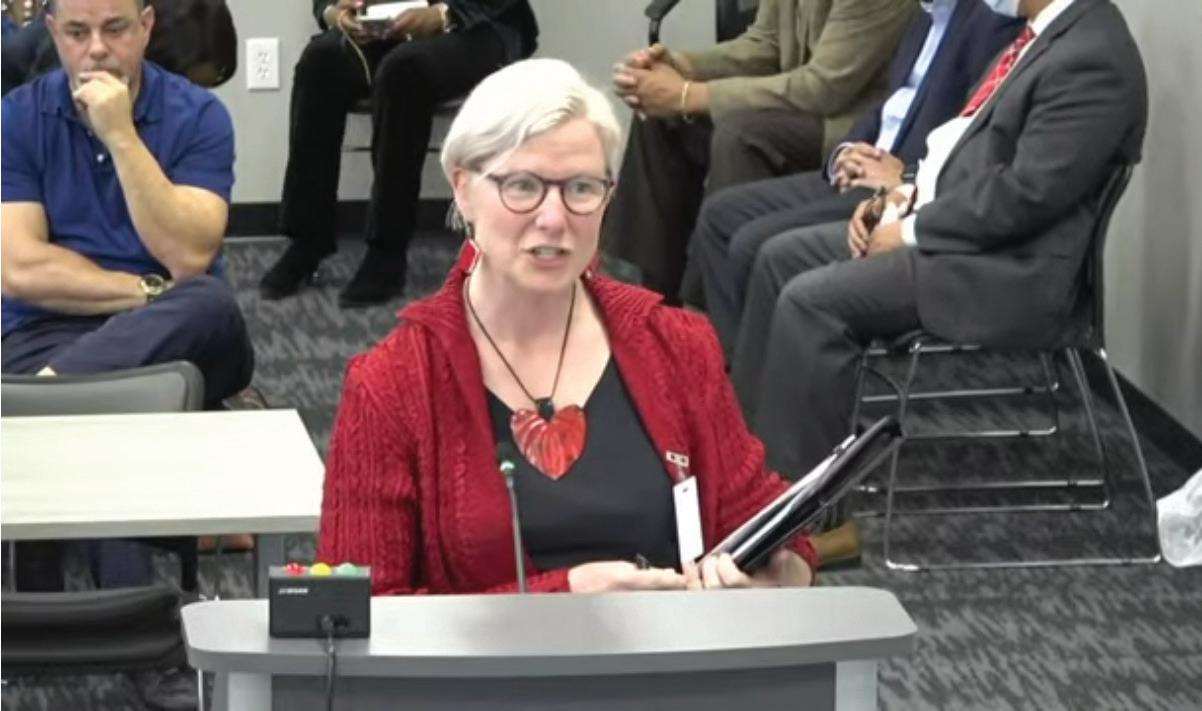
N4BN will be responsible for managing the overall operations of Cure Violence, including hiring staff members and following the project’s requirements and goals. The organization plans to work directly with community members to overcome barriers to access to employment and workforce training. They have already begun hiring, with plans to implement the program early next year.
Applications for roles with Better Neighborhoods are open and can be found online at Indeed
Neighbors for Better Neighborhoods Executive Director Latoya Robinson estimates the collaboration will create eight job openings, including one site manager, one site director and two outreach workers. She believes the program will reduce violent crimes throughout the city.
“We’re hoping to get a lot of people interested and want to participate,” Robinson said. “[The goal is to] not only focus on interrupting the crime but trying to connect with people in the communities and connect them to resources to help address that community as a whole.”
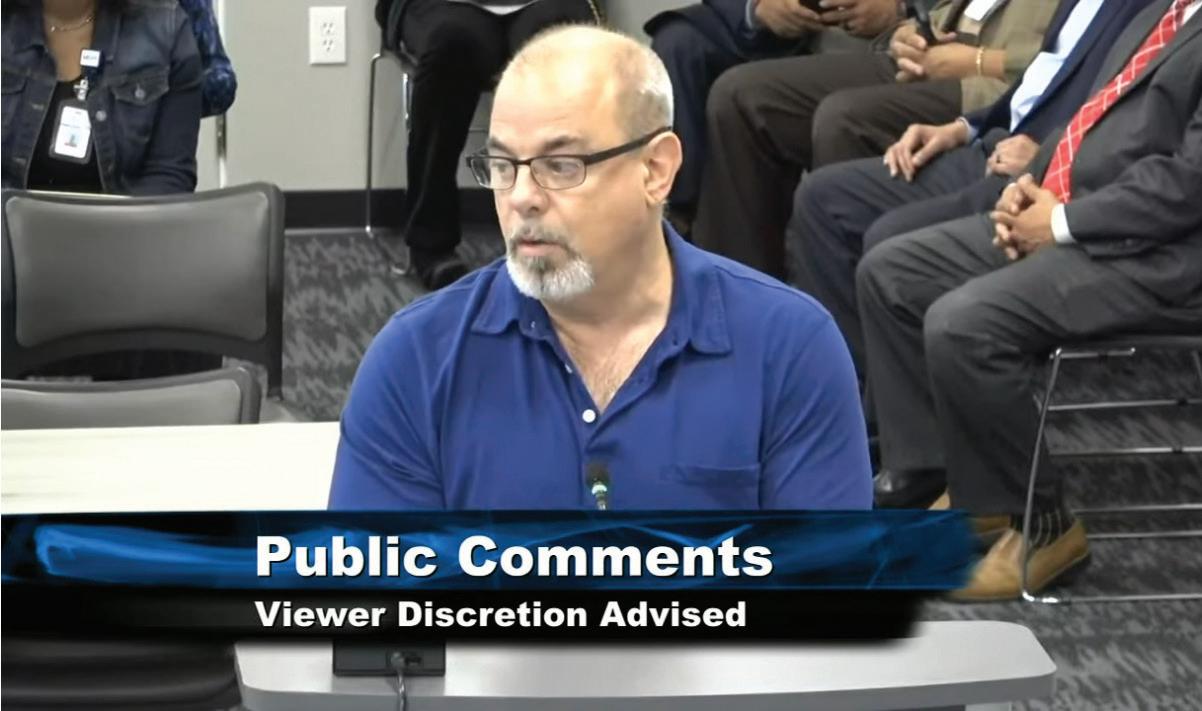
5 NEWS | DEC. 1521 , 2022
NEWS
Northern High School parent Jim Morris and Guilford County Schools Media Services Director Natalie Strange speak during the Dec. 8 book challenge hearing. SCREENSHOTS
In 2021, Winston-Salem ended the year with a record number of 44 homicides, according to the Winston-Salem Police Department but saw an overall decrease of violent crime.
Winston-Salem will be the third city in North Carolina to implement the Cure Violence program, following Greensboro and Durham.
Greensboro partnered with the organization in 2019 after the Greensboro City Council voted unanimously to give the program $500,000, as TCB has reported in the past.
In the fiscal year 2021-22, Durham’s Cure Violence initiative held 1,365 mediations, according to a presentation given to Durham City Council on Sept. 8.
These mediations may have led to a decrease in violence for the city, which saw a 9.05 percent decrease in violent crime from 2021 to November 2022, according to Durham Police Department Crime data.
In particular, violent crime committed by young people is a significant concern.
Rich Smith with the NC Dept. of Public Safety told TCB violent crime has decreased overall, but offenses are becoming more severe in Winston-Salem.
Winston-Salem saw a 6.8 percent decrease in violent crime compared to 2020, according to the Winston-Salem Police Department’s 2021 Annual Statistical Report.
Smith said there is a high percentage of youth at risk of reoffending within Forsyth County. Compared to the state’s overall recidivism level of 19 percent, in Forsyth County, 30 percent of youths who committed violent offenses did so again.
The model used to estimate rates of recidivism is calculated from data collected in three areas for each offender: pre-existing factors, such as criminal history; current involvement in the criminal justice system, including recent convictions; and measures of social reintegration, such as arrests during follow-up, according to North Carolina Sentencing and Policy Advisory Commission.
Robinson hopes the Cure Violence initiative will provide Winston-Salem with resources, community organizing, community engagement and mediation to prevent violence.
Once in operation, the Winston-Salem Police Department will continue to
handle all criminal investigations, but Cure Violence will work directly in communities to curtail violence before it happens by talking with community members to better understand the root causes. This includes identifying at-risk individuals and working with them to change their behaviors and providing opportunities through job training, substance abuse treatment or help leaving gangs.
“We work with many different neighborhoods throughout Winston-Salem doing boots-on-the-ground work,” Robinson said. “Not only to focus on interrupting the crime but try to connect with those in the communities to find out if any resources are needed. We connect them to resources that help address the community as a whole.”
Cure Violence will also help “cool down emotions” after shootings or other violent crimes.

“We’ll have violence interrupters and those people will be working boots on the ground in the community, trying to help identify the folks involved in the [crimes] happening and help change some of those behaviors,” Robinson explained. “We’ll be doing ongoing mediations to address conflicts and community organizing to help mobilize community change within the area.”
The initiative will focus on Police Beat 222, areas between Martin Luther King Jr. Drive and New Walkertown Road to 18th Street and Bethlehem Lane east of US 52 in the city.
The decision to partner with Cure Violence has been in the planning stages since the start of 2022.
On March 3, 2022, Cure Violence was approved by the Forsyth County Board of Commissioners as an ARPA-funded project with a total budget of $1.5 million.
Forsyth County and Winston-Salem will each pay half over a three-year period.
The program has yet to start officially but is expected to run until the end of 2023, according to the Forsyth County Board of Commissioners meeting on Oct. 13.
6 NEWS | DEC. 1521 , 2022 NEWS
[The goal is to] not only focus on interrupting the crime but trying to connect with people in the communities and connect them to resources to help address that community as a whole.
Latoya Robinson “
“
OPINION
EDITORIAL

Stealing from poor people is barely a crime
It’s easy to take advantage of poor people. They have very little power, or access to it. They have few recourses when they have been done wrong, because most of those recourses cost money. And stealing from poor people — especially in systemic forms such as wage theft, usury and price-gouging — is not even really a crime in the way that we normally think about such things. Last week, the NC Dept. of Agriculture & Consumer Services reported “price scanning errors” in 70 stores in 38 North Carolina counties.
“Over the last year we have seen about 26 percent of price scanner inspections fail,” Agriculture Commissioner Steve Troxler said. Understand this is a statewide number; of every scanner inspected in NC, 26 percent of them are making errors.
Of the 70 stores that the department found to be overcharging their customers, 28 were Dollar General stores, 19 were Family Dollar stores and 15 of them were Walmarts — 88.6 percent of the list.
In 2021, Dollar General operated 18,190 stores in 47 states. With annual sales in 2021 of $34.22 billion, single-store sales averaged $1.9 million per year. In 2021,


Dollar General posted an operating profit of $3.2 billion.
All 28 Dollar General Stores that were stealing from their customers in NC — which combined did as much as $53 million in annual sales based on the single-store average — were fined a total of $80,300 by the state, with fines capped at $5,000 for the worst offenders. Twenty-two of the 70 stores were fined $5,000 for error rates ranging from 5.33 percent, at the Walmart on Hendersonville Road in Asheville, to 34.4 percent, at the Advance Auto on Glenwood Avenue in Raleigh.
Important to note: Overcharges were calculated on a per-item basis, not as a dollar amount. For example, the Family Dollar on South Main Street in Winston-Salem paid a $5,000 fine on an error rate of 27.33 percent, which means 82 of 300 items tested were overpriced. So we have no way of knowing just how much money these stores were stealing from their customers, but mathematics tells us it could be as much as $1,000 per day — that’s based on a single-day sales average of $5,156 with an average item price of $3 and an average overcharge of 65 cents.
All we know is that they paid their fines and then went right back to business.

7 OPINION | DEC. 1521 , 2022
All 28 Dollar General Stores that were stealing from their customers in NC were fined a total of $80,300 by the state.
Q&A
Brandon Wrencher talks new book, Buried Seeds, and how historical Christian movements inform social justice
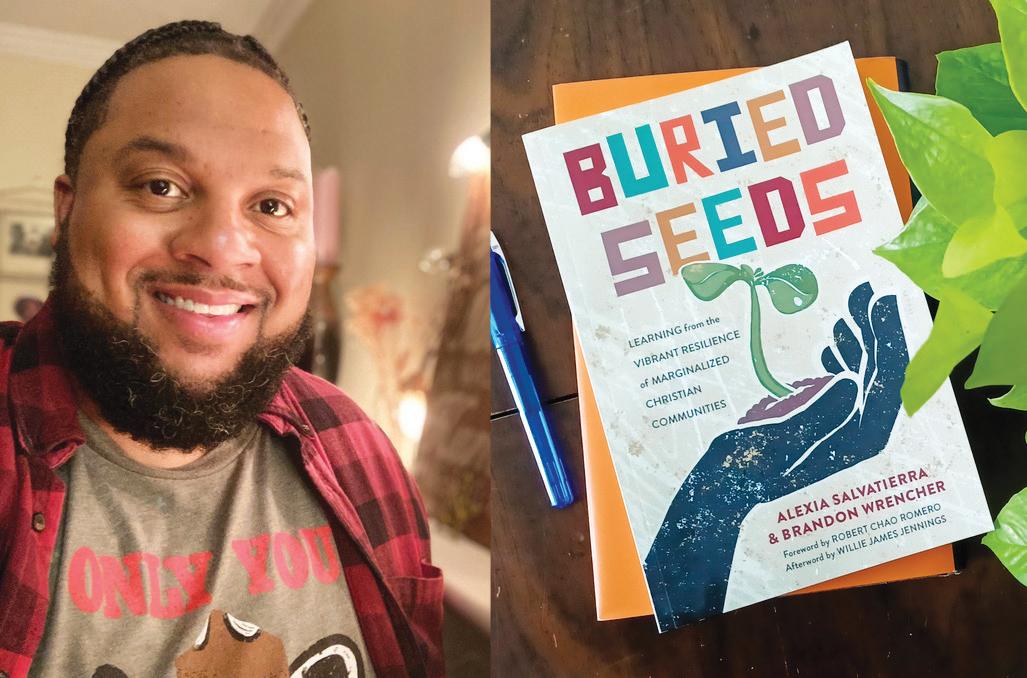 by Sayaka Matsuoka
by Sayaka Matsuoka
Brandon Wrencher is a senior organizer with Guilford For All and the founder of the Good Neighbor Movement in Greensboro. In October, Wrencher’s second book, Buried Seeds, was published. The book takes a look at how hush harbors of the American Deep South and base ecclesial communities of the Global South offer strategies for modern church and social-justice movements.
QTell me about your background.
I’m from the Sandhills area of the Piedmont and I come from a Black, working-class family, small-town life. I grew up in two different Black church traditions: Baptist and Holy Pentecostal; there were no more than 50 or so people in those churches. I grew up in those traditions, but what shaped me more than that was the faith of my mother. She grew up with a faith background but was always a free-thinking person; she would question things and was willing to question the status quo. In most Black Baptist churches in the South, women aren’t supposed to be speaking up, but my mom did that. She wore pantsuits and earrings and lipstick; she was sassy. I didn’t realize that was a problem for her until I grew up.
And as I learned more about Jesus, I was like, Jesus is like my momma Then when I went to college at UNC, I fell away from faith. But I was introduced to womanist philosophy, and that changed everything. It changed me to be an organizer and a minister.
How did you come to Greensboro?
I was asked to come to Greensboro to start a faith community in 2017 by the United Methodist Church. It was to be a downtown community that was multiracial and led by Black folks. I started the Good Neighbor
Movement that year.
Starting any faith enterprise is just a really difficult thing to do. It takes a certain kind of energy and leadership. Most church plants are kind of gentrifying forces. They don’t root themselves in a place; it looks much more extractive. I recognized immediately, This doesn’t feel good. So I sought out mentors of mine.
I started talking to people like Rev. Nelson Johnson and my co-author Alexia Salvatierra, and I began listening to them. And we were like, “You know, maybe we have in our lineages, Black and brown lineages, the seeds of what it means to start new faith communities for spiritually underserved communities.” Through an organizing path rather than a kind of social entrepreneurship or business model of starting a new venture.’ That’s when we began to read more about the two traditions that formed the basis of the book.
Tell me more about the traditions of base ecclesial communities of the Global South and the hush harbors of the US Deep South.
A
So base ecclesial communities were a movement within the Catholic Church mainly in the global south, mainly in Latin America. It was a response from people who were not ordained, who were poor, who could not afford full-time clergy in their parishes.
8 CULTURE | DEC. 1521, 2022
Q
A
CULTURE
Q A
CULTURE
From the very beginning it was an act of protest, a justice act to say, “We deserve to be able to have houses of worship where our leadership can be developed and where we can have the full range of what it means to be a faith community.”
What happened is that these poor folks, brown and Black folks, began to form their own faith communities. They were led by non-ordained folks from working-class backgrounds as small groups who shared leadership.
Hush harbors were similar. Enslaved Africans were only permitted to worship in two different ways: in multiracial but predominantly white churches where white ministers had power, or in slave quarters with a Black congregation but also white leadership. These were still in the gaze of white supremacist religiosity. Then, some enslaved Africans said, ‘These are false choices; our worship shouldn’t be controlled.’ And they went off into the woods at night illegally. They would take bits and pieces of what they learned about Christianity and blend it with African traditional practices and made a faith and church of their own outside of the surveillance of the plantation.
They were an unsettling force. They were the buried seeds that really animated so much of the movements at that time including the abolitionist movement.
QIt seems like younger generations don’t consider themselves religious, but you push back against that notion in the book.
A
It depends on what we mean by church and religion. In those backgrounds, they pushed back on what the definition of church and religion is. What I try to show in the book is not just what’s happening in the past, but examples of where young people — any people — who have left institutional religion have found meaning making or spaces to make big changes in their lives. That these function in similar ways to what religious institutions used to function as. Places like barbershops, activist groups, artist spaces — these function for many people as sacred
spaces. They may not have doctrine; that was what I was after. I want to push back on that narrative without being insensitive to that. Tons of young people have an absolute allergy to the ways organized religion operates today because it can be hateful. But to be critical or to refuse does not mean we limit what can be and what we create for us. And if we are going to have a power analysis where we learn how to resist the most fascist and, frankly, evil forces, we can’t discard and dismiss comrades because we need one another.
QWhat do you hope the future of Christianity in this country looks like?
AWhen I think about my ancestors and the risks that they took to create sacred spaces that would feed their souls, that would love their bodies, that would free them to fight for a world where nobody is without or where nobody is treated without dignity, I don’t believe that is limited to Christianity. But I think that Christianity still has ingredients for that kind of movement to rise again in these times, just look at the Poor People’s Campaign. So it’s less about where I want Christianity to go in this country, but where I want to shift attention.
I want to focus more on these clandestine, off-the-beaten-path, grassroots ways we live out spirituality and faith that is much more about love of self, love of people and a desire for a world where everybody and every creative thing belongs. That is happening all over the place. My desire is that we learn to be good cartographers so that we can map and find and honor those places, because those places will always be there. That’s the idea behind buried seeds — they are always there.
On Sunday, Dec. 18, Wrencher will be talking about his book at Scuppernong Btooks in Greensboro at 2 p.m.

9 CULTURE | DEC. 1521, 2022
Triad artists are first to be featured in nationwide ArtCities exhibit
by Michaela Ratliff
Local artists need love, too.
That’s why earlier this year Derek Wiggins and Karen Wong founded Guilty By Association, an organization dedicated to raising visibility for underrepresented artists nationwide.
While ArtCities is a national project by Guilty By Association, the organization teamed up with Wake Forest University’s Wake the Arts initiative to host the first ArtCities House Party on Dec. 11 at the Milton Rhodes Center for the Arts. Five local artists — Krystal Hart, Ashley Johnson, Lakea Shepard, Mariam Aziza Stephan and Antoine Williams — were carefully selected by WFU Acquavella Curator of Collections Jennifer Finkel.
“What we’re simply trying to suggest is that there’s so much talent hidden in plain sight,” Wong says, “that the artists who live and work in our regional cities are just as good if not better than artists working in New York or LA.”
During the event, attendees learned more about the organizations, mingled with artists and purchased art.

Art buffs navigated the room, discussing their interpretations of the works they were viewing. Some visitors formed a semicircle in front of the flat-screen television. With crossed arms, raised eyebrows and faces indicating interest, they took in a documentary created by WFU’s documentary film students. Artist Lakea Shepard shook hands with fans of her traditional African art-inspired head coverings and masks.
Her father was a sculptor and mechanic; helping him in her youth led Shepard to fall in love with working with her hands. A fellow sculptor and mixed-media artist, Shepard selects each jewel and gemstone used in her pieces with intention.
“It’s important that I know where and what the materials are made of and where they come from,” she says.
In her work “428 A Gram,” she uses traditional African techniques like weaving and forcefully manipulates waxed linen, beads and even bullet casings to create a mask inspired by those worn during slavery in the United States. After learning masks were used as a means of punishment or to prevent the enslaved from eating crops as they worked on plantations, Shepard reimagined the sordid history of protecting the crops into something beautiful, using some of the men in her life as inspiration.
“I took that idea of protection and flipped it in a more positive manner,” she says.“I wanted to take a piece of every Black man that I know, and take a piece of what I’ve witnessed in their lives and try to explore it in a more positive manner.”
There in support of Shepard was her partner, Brandon Edwards, who appreciated the art of Ashley Johnson. He enjoys videography and photography, so he was drawn to portraits from Johnson’s series.
“It’s the one that stuck out to me as far as the statement behind the work,” Edwards says.
The series was inspired by a dream of Johnson’s in which a group of Black boys ran out of a group home and down a flight of rainbow stairs. They painted each other’s backs orange and proceeded to take photos. Johnson used this idea to capture performative photographs that aim to highlight all areas of the Black experience, no matter how uncomfortable. In “...From Baptisms,” two shirtless Black men are sitting in murky waters, heads dropped and their backs facing the viewer. A white sheet extends from behind one of them. A possible interpretation of this piece is that the orange paint on their backs could symbolize blood from lashings, and the men represent the enslaved who await their next destination.
“I really want people to see themselves through it, even if it’s difficult. I really want people to ask themselves complex questions when they look at my work,” Johnson says in the documentary.
Each artist used a different medium of expression in their work, which gave variety to the exhibit. Antoine Williams favored black ink pens for his drawings of monster-like humanoids dressed in urban apparel. Miriam Aziza Stephan, inspired by the Egyptian landscapes she viewed during an extended stay in graduate school, used muted tones of gray and blue to emphasize Earth’s many shapes, forms and textures. Krystal Hart worked with natural materials like soil, fiber paper and general pigments to create collage-like pieces that emphasize the importance of sourcing materials from the earth.
According to Shepard, ArtCities has already proven beneficial to promoting underrepresented artists. Two of her pieces have sold, and as far as being among the first artists to be featured in person and online, it’s a joyous occasion.
“It feels amazing,” she says. “This opportunity has really affected my career in a very positive manner already, and we’re just beginning.”
Learn more about Guilty By Association, ArtCities and the featured artists and view the documentary at gba.family. For more information about Wake the Arts, visit wakethearts.wfu.edu.
10 CULTURE | DEC. 1521, 2022
Artwork by Lakea Shepard is displayed on podiums in front of paintings by Krystal Hart at the ArtCities pop-up exhibit at the Milton Rhodes Center on Dec. 11
COURTESY PHOTO
SHOT IN THE TRIAD
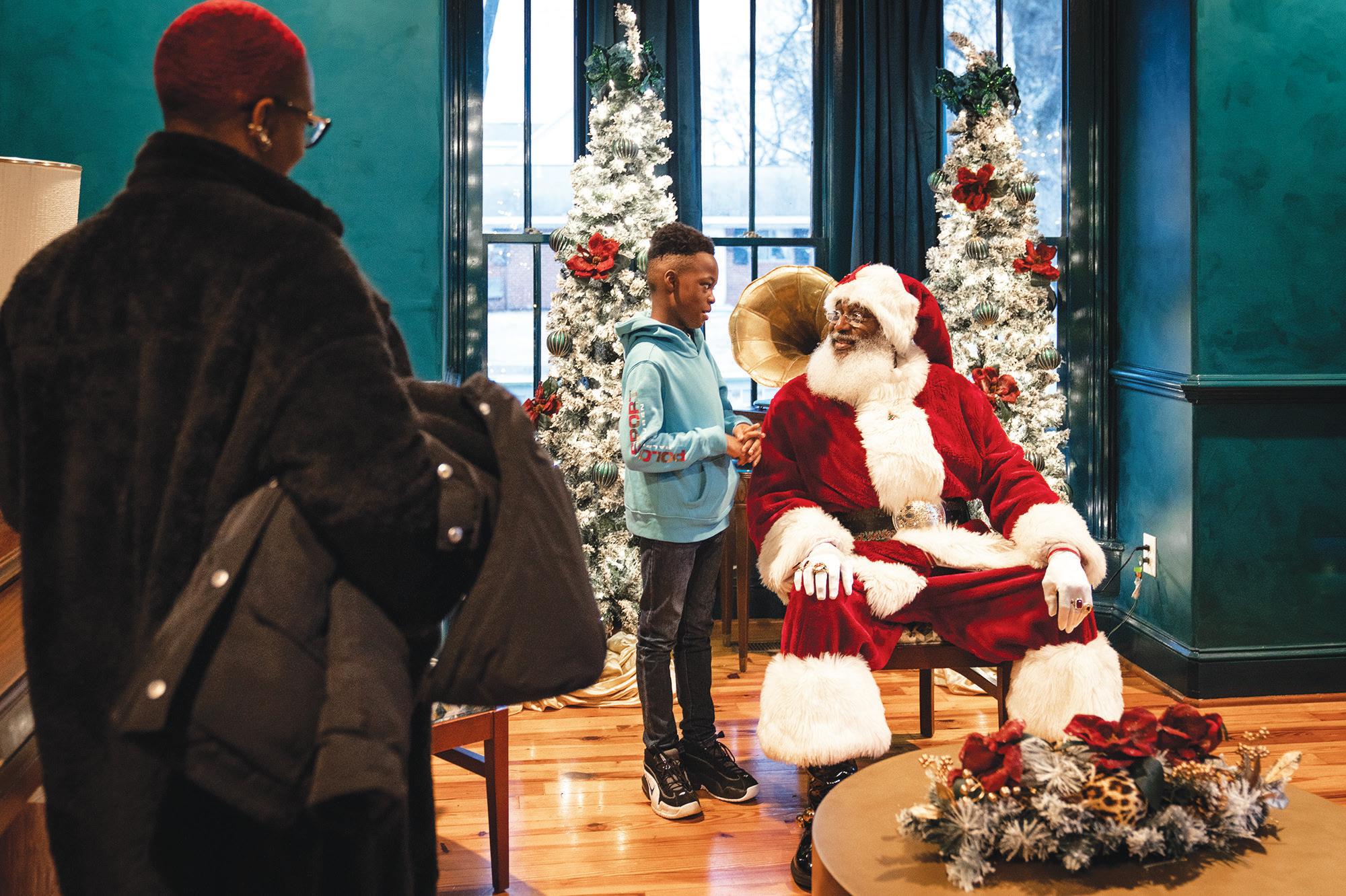 BY CAROLYN DE BERRY
BY CAROLYN DE BERRY
Gorrell Street, Greensboro

11 SHOT IN THE TRIAD | DEC. 1521, 2022
King Gates, 8, chats with Santa while Marian Bonds looks on at the Historic Magnolia House in Greensboro.




‘You Down With That?’ — it’s only by nature. SUDOKU LAST WEEK’S ANSWERS: Across 1. Get by reasoning 6. Obey “You shall not pass”? 10. Dull pain 14. Anatomical trunk 15. Radius partner 16. “Moby-Dick” captain 17. Poster phrase discouraging theft of intellectual property 19. “The Lion King” heroine 20. “___ fêtes!” (“Happy holidays,” loosely) 21. In a cheaply assembled way 23. Black or red insect 24. FedEx alternative 26. Part of a wedding ceremony 27. Family tree entry (abbr.) 29. Shucked shellfish 32. Letters before “Miami” or “NY” 35. Most important items 38. Twinkie filling 40. “Celebrity Jeopardy!” finalist Barinholtz 41. Pacific Northwestern pole 42. Easy-to-understand self-help genre 45. “Six-pack” muscles 46. Disposable in a box 47. Sahara slitherers 50. Place for a golf ball 51. Six-pointers, in the NFL 53. “Argo” employer 54. Area above the ankle 59. Let out fishing line 61. Setting of “Reading Lolita in Tehran” CROSSWORD 62. Markable spots on the map showing where to land on the island, in Fortnite 64. Waiting room word 65. “Stranger Things” waffle brand 66. Renée Fleming performance, perhaps 67. Chest items 68. Video game with an “Eternal” sequel 69. Coins in Mexico Down 1. “You’re not gonna like this ...” 2. Zip 3. Way to get onto the porch 4. “Around the Horn” airer 5. Captured a dogie 6. Pet hair 7. Rueful remark 8. Rainfall measurement 9. Time between flights 10. Barq’s competitor 11. Spiced tea brewed in milk 12. Concert venue 13. “The World’s Online Marketplace” 18. “When ___, the world gets better, and the world is better, but then it’s not, and I need to do it again” (2009 Isla Fisher movie line) 22. Triangle in a bag 25. Karaoke display 28. Give a free ticket 30. Guru Nanak’s followers 31. Tire alignment used on racecars 32. Some paintings of urban life 33. Recognize
34. Intellectual’s ending 36. Be a bother to 37. Frat party outfit 38. Pre-Apr. 15th advisor 39. Actor Corddry of “Childrens Hospital” 43. Produced, as crops 44. Approached, with “to” 48. “Cavalleria Rusticana” composer Mascagni 49. Chip condiments 50. Campground array 52. Martha’s
on VH1 54. Laundry leftover 55. Dessert released in 1912 56. Crayon-like 57. Therefore 58. Belinda Carlisle, once 60. Ready to be eaten 63. “Wonderful” juice brand
by Matt Jones by Matt Jones
cohost


















 by Sayaka Matsuoka
by Sayaka Matsuoka


 BY CAROLYN DE BERRY
BY CAROLYN DE BERRY




